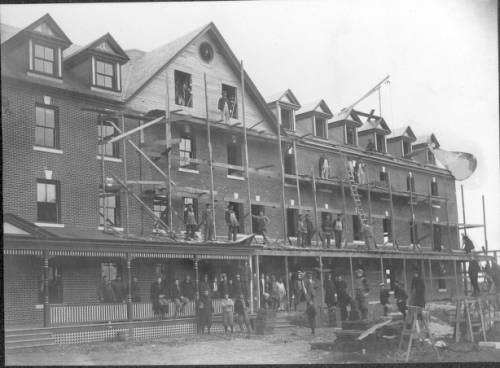
By Matt Heller
Executive Editor
When the State of Vermont Natural Resources Board approved the plan to demolish Founder’s Hall last month, it did not give the green light for the school to start taking down the original building of Saint Michael’s College right away. After the November 12 approval, a 30-day appeal window began.
Sara Dillon ‘77, who heard about the plans to tear down the building about a year ago, said she was speechless when she found out and will appeal this most recent decision.
“Once you knock down that building and it’s gone, I think you’ve really lost the soul of the college,” Dillon said.
In her request for party status, Dillon said that the school has neglected the building and that an independent and objective assessment of the Founder’s was absent. However, in 2009, Hartgen Archaeological Associates conducted a report on the building, determining it to be in poor condition with major deficiencies. Additionally, Joel Ribout, Associate Director of Facilities, said a 2011 report on the building was conducted by an outside structural engineer, a mechanical engineer, and an architect.

(Photo courtesy of Saint Michael’s Archives)
Founder’s Hall, built in 1904, was once the entire college. In recent history, the administration has occupied offices on the first floor, with students living on the other three. The building has been vacant after administration’s departure this past summer.
In 2014, the Vermont Division for Historic Preservation reviewed the project and recommended to the Act 250 program that it would have an Adverse Effect, Not Undue. According to Laura Trieschmann, State Historic Preservation Officer, this means that the demolition will have adverse effects regarding historic resources, but essentially, there weren’t any alternatives.
Act 250, Vermont’s land use and development law, seeks the “Not Undue” status by mitigating adverse effects. In terms of Founder’s Hall, this means saving and restoring the Annex, as well as preserving the cupola. According to Trieshmann, a restoration of the building would essentially be a reconstruction. While reconstructions aren’t rare, they do degrade historic integrity and can be costly.
According to Ribout, Founder’s demolition will cost around $750,000 and will be conducted by Casella Waste Systems. With additional permitting and engineering fees, the total project cost will be around $1 million. This is significantly less than a restoration of the building, which, Ribout said, would cost between $10 and $20 million.
In the event that the building stays, Dillon has ideas such as turning it into an admission center or an archival display, even if this costs $10 or $15 million.
“Further annoying me, [the administration] pitted the students against the building. I’m not against the students, I just think it’s a separate stream of money,” Dillon said. While there are historic preservation grants available through the state, they are capped at $20,000.
The Society of Saint Edmund offered communal support for the demolition. A letter signed by Superior General Very Reverend David G. Cray says that the Edmundite contribution to the school has been spiritual and intellectual, not architectural, and the heart of the college is in the people, not the buildings.
“I think it’s unfortunate that we’re at this point, talking about a historic building this way, but I get the challenges. The priority is to educate, not preserve buildings, and it’s very difficult to do both,” Trieschmann said.
While she couldn’t think of any specific examples of colleges tearing down their original buildings, Trieschmann said it’s not necessarily a rare occurrence. She mentioned that the University of Vermont and Middlebury College are regularly challenged to provide maintenance to their historic buildings to meet current standards.
“A lot of schools are short changing their maintenance so that it’s costing them more to fix a building than it should. They’re having to look and say, ‘Is this a building we can either deaccession or do we just have to tear it down?’” she said.
Dillon will have until December 12 to appeal the decision. If granted party status, she could request a public hearing and shift her argument to the merits of the building as opposed to why she should be considered an interested party.
As the building continues to stand unoccupied, the school still has to heat the inside to prevent burst pipes, Ribout said. As time goes by, it will become more and more evident that the building is not being used.
“Having something sit there and become apparent that it is not coming down, I think is worse than having it come down now,” Ribout said. In the absence of a successful appeal, Ribout hopes that the building would be down in March and the cupola would be preserved in place by the spring.
That’s the last thing Dillon wants to see.
“If they go ahead and demolish it, I will be very, very angry for a very long time because it all seems so unnecessary. That’s poor planning over a long period of time and poor management, in my opinion,” Dillon said.
Conflicting voices over cupola preservation
Ribout said the college intends to preserve the cupola, the structure found at the top of Founder’s as well as on the college’s logo. However, without a full understanding of its condition, the school has agreed to work with the Division for Historic Preservation on a restoration project that would act in the interest of both parties, and therefore satisfy stipulations of the Act 250 permit. This means that if the cupola is not in good condition, complete preservation may be compromised.
Trieschmann said the cupola is to be saved and preserved. If not, she said it would re-open the permit. In the November 12 land use permit issued by the state, one section states that the school should remove the belfry (cupola) in a way that it can be preserved and viewed by the campus community. It also says that the school should consult with VDHP for a final preservation plan.

